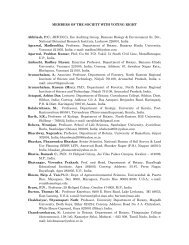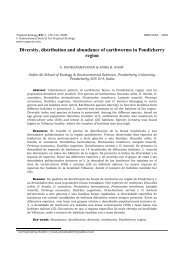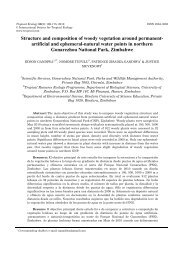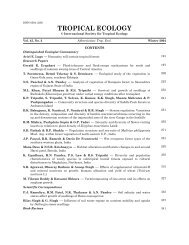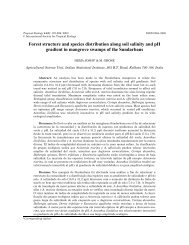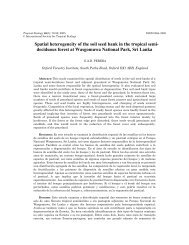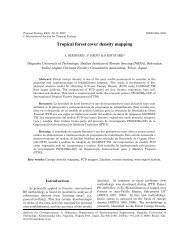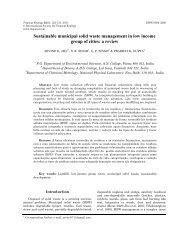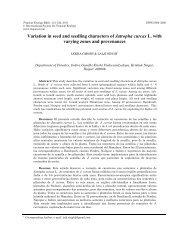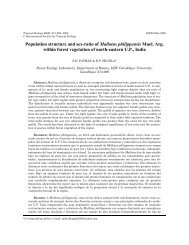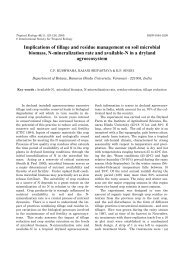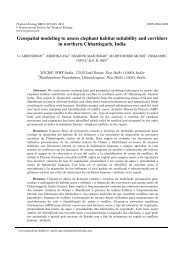94 BIODIVERSITY AND SUSTAINABLE DEVELOPMENTforem marginalizados por um longo período, elas podem adoptar acções que são detrimentaispara os objectivos da conservação. Capitalizar nas dimensões positivas do cohecimento tradicionale ultrapasar a sua dimensão negativa através de inputs de base científica podem facilitaro processo difícil de garantir a participação da população na conservação ambiental juntamentecom o desenvolvimento sócio-económico das comunidades locais.Key words:Biodiversity, natural resource management, rehabilitation ecology, <strong>sustainable</strong> livelihood,traditional <strong>knowledge</strong> <strong>and</strong> technology.IntroductionThe Himalayan mountain system covers only18% of the geographical area of India, but accountsfor more than 50% of India’s forest cover <strong>and</strong> for40% of the species endemic to the Indian subcontinent.Himalayan resources <strong>and</strong> ecosystem servicesare critical, not only for the <strong>sustainable</strong> livelihoodof 115 million mountain people, but also for amuch larger population inhabiting the adjoiningIndo-Gangetic plains. Depletion of forest cover,<strong>biodiversity</strong> <strong>and</strong> terrestrial carbon stock, decliningfarm productivity, increasing hydrological imbalance<strong>and</strong> soil erosion are interconnected problems<strong>and</strong> the root-causes of the poor economy of the hillpeople <strong>and</strong> threaten global environmental benefitsfrom the Himalayas (Chipika & Kowero 2000;Hamilton 1987; Hurni 1999; Ives & Messerli 1989;Myers 1990; Ramakrishnan et al. 1996).Until the 1970s, environmental conservation<strong>and</strong> rural development were, by <strong>and</strong> large, treatedas independent sectors. The poor results broughtby the sectoral approach catalyzed efforts towardsthe integrated approach, which targets the resolutionof environmental <strong>and</strong> socio-economic problemssimultaneously. Though <strong>knowledge</strong> of the principles<strong>and</strong> potential advantages of this approach hasimproved considerably in recent years, there aregaps in <strong>knowledge</strong> <strong>and</strong> serious problems in puttingthe theory to practice (Antunes & Santos 1999;Bellamy & Johnson 2000; Jenssen & Goldsworthy1996; Lunde & Iremonger 2000).A simplistic view of integrated managementwould be to identify ‘key’ interventions [analogousto the concept of keystone species (Paine 1969;Walker 1991)] enabling environmental <strong>and</strong> socioeconomicbenefits simultaneously. There are twodivergent approaches to the characterization of theproblem-complex (multiple interlinked problems)or key interventions to overcome the problemcomplex:(a) building on the ways in which nature,resources <strong>and</strong> livelihood have been viewed by theindigenous/traditional communities, which hasbeen referred to as the ‘internal perspective’ approach(Hurni 2000) or as the indigenous <strong>knowledge</strong>-basedapproach or the bottom-up approach;<strong>and</strong> (b) the conventional scientific approach, orglobal economic <strong>and</strong> environmental world-view,referred to as the ‘external perspective’ approach(Hurni 2000), or top-down approach. <strong>Indigenous</strong><strong>knowledge</strong> is an integral dimension of all societiesbut is more intact in areas, such as high-altituderemote Himalayan villages, where inaccessibility<strong>and</strong> isolation have acted as barriers to outsideforces for a long period of time. In this article, wediscuss some aspects of indigenous <strong>knowledge</strong>basedresource uses of management practices <strong>and</strong>changes therein, <strong>and</strong> of the scope for integratingindigenous <strong>knowledge</strong> <strong>and</strong> conventional <strong>ecological</strong>science for resolving <strong>biodiversity</strong>/environmentalconservation-development conflicts, within thecontext of the Himalayan mountain systems.Forest/wild <strong>biodiversity</strong>: impacts ofinterventionsCrop husb<strong>and</strong>ry, animal husb<strong>and</strong>ry, wild <strong>biodiversity</strong><strong>and</strong> rural economy are subsystems of theintegrated traditional resource management system.On a regional scale, the l<strong>and</strong>scape can be differentiatedinto: i) settled crop-livestock mixed agriculturepatches dispersed in the matrix of forests<strong>and</strong> pastures; ii) almost pristine areas (permanentsnow area <strong>and</strong> adjoining alpine vegetation) practicallyimpossible to access for any consumptive resourceuse; iii) the remaining areas that are used
RAO et al. 95for summer grazing by transhumance communities,the Gaddis <strong>and</strong> Bakarwals, who bring livestockfrom the distant foothill regions <strong>and</strong> the Anwals,Tarjias <strong>and</strong> Dogpas who supervise the livestockof the local hill communities. Traditionalsocio-cultural mechanisms of fostering systematic<strong>and</strong> regulated use of wild plant resources seem tohave evolved as a necessity to optimize economicoutputs from domesticated <strong>biodiversity</strong>. All acrossthe region, traditional management systems arecharacterized by practices favouring a balance inutilization <strong>and</strong> regeneration of the natural resourcebase, equity <strong>and</strong> social integrity to achievethe ultimate goal of <strong>sustainable</strong> livelihood withinsmall-scale subsistence economies in highly isolated<strong>and</strong> inaccessible mountain settlements. Conventionalapproaches to conservation, i.e., the establishmentof wildlife sanctuaries <strong>and</strong> nationalparks, have assumed traditional practices to bedetrimental to the conservation of wild <strong>biodiversity</strong><strong>and</strong> the functioning of ecosystems. This assumptionis the root-cause of people-conservation conflicts(Gadgil et al. 1993; Gomez-Pompa & Kaus1992; McNeely 1988). The nature <strong>and</strong> magnitudeof these restrictions, their impacts on local livelihood<strong>and</strong> people’s responses to them may vary dependingupon the <strong>ecological</strong> <strong>and</strong> socio-economic<strong>and</strong> cultural contexts.Traditional forest/wild <strong>biodiversity</strong>managementTraditionally, each village had notional territoriesof forests <strong>and</strong> alpine meadows <strong>and</strong> resourceuses within these ‘common l<strong>and</strong>s’ were decided bythe consensus of the communities. Even thoughlocal people were aware of potential economicbenefits from timber, the timber trade was neverpractised because they traditionally viewed theutilization of non-timber forest products <strong>and</strong> ecosystemservices to be more valuable for <strong>sustainable</strong>livelihood than timber. In the traditional system,there was no restriction on the collection ofwild edibles, deadwood <strong>and</strong> leaf litter (to be usedas a constituent of manure applied to crop fields),partly because these resources were abundant.Lopping, grazing <strong>and</strong> utilization of forest productssuch as medicinal plants <strong>and</strong> bamboos (raw materialfor h<strong>and</strong>icrafts) used to be undertaken ingroups during periods fixed by the consensus of thecommunity so as to reduce the risks of overexploitationby individuals. Traditions such as thesocial sanction to market forest resource-basedh<strong>and</strong>icrafts, medicinal plants <strong>and</strong> nomadic grazingonly by smallholders <strong>and</strong> l<strong>and</strong>less people fosteredequity to a significant extent. Villages rich in someresources due to comparative <strong>ecological</strong> advantages(e.g. villages close to the alpine zone arericher in summer fodder, temperate bamboos <strong>and</strong>medicinal plants than those in mid-altitude zones<strong>and</strong> those in foothills which are richer in winterfodder) allowed other villages to use their resources,more from the point of achieving socialintegrity than from the point of economic gains(Maikhuri et al. 2000a,b; Rao & Saxena 1996). Localcommunities traditionally allowed grazing oflivestock from outside the region supervised bynomads for three reasons. First, nomads used thearea not grazed by local livestock <strong>and</strong> hence didnot offer any threat to local livelihood. Second, thepresence of livestock brought by nomads to the areasaround the villages reduced the probability ofdepredation of local livestock. Third, the nomadsbartered essential commodities, which were notavailable locally <strong>and</strong> brought from the foothillswith local products.Leopards <strong>and</strong> wolves are the two major predatorsof livestock studied in the region. In highaltituderegions, local people view wolves as amore serious threat than snow leopards becausethe former is a year-round predator on domesticlivestock, whereas the latter attacks mostly duringextreme winters. Estimates on livestock killing bysnow leopards fall within a range of 1% to 12% oftotal stockholding (Fox et al. 1988; Jackson 1991;Mallon 1991; Mishra 1997; Oli et al. 1994; Schalleret al. 1987). The assessment of killings by wolveshas not received as much attention as those bysnow leopards. Precise estimation of predationlosses is difficult because predation as a proximatecause of livestock death is confounded with ultimatecauses such as disease, malnutrition, badweather or accidents. All assessments of livestockdepredation are based on killings reported byfarmers who often deliberately inflate the figures.Livestock are less able to escape predatorsthan wild herbivores (Nowell & Jackson 1996).Local people traditionally accepted depredation asa natural hazard. Several measures are taken tominimize this loss. First, grazing of goats, sheep,donkeys <strong>and</strong> cows is kept close to permanent settlements.Two families, by rotation in a village,




